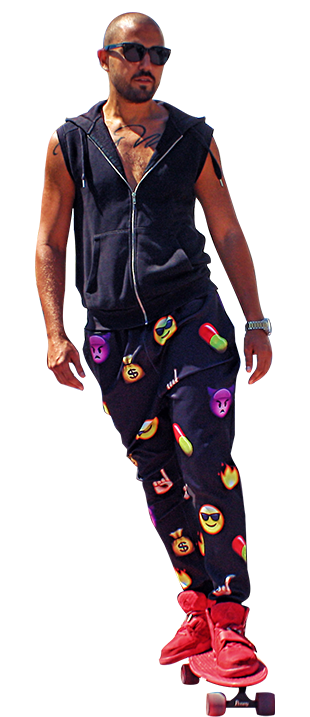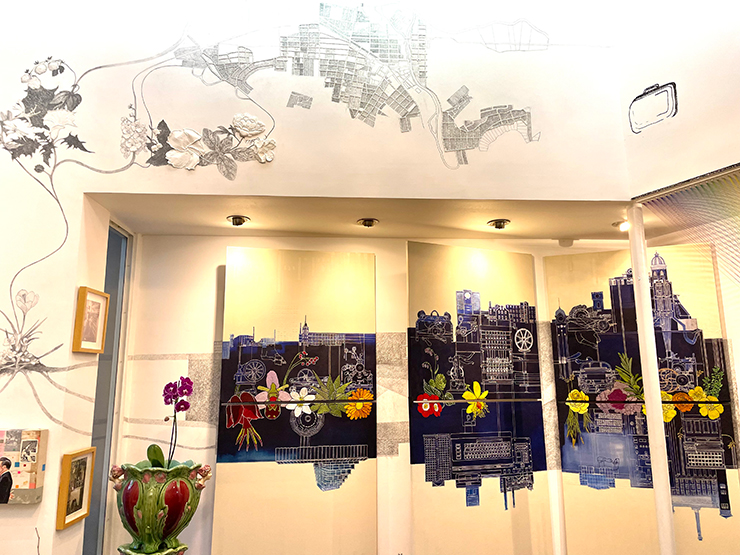
Bernice Steinbaum Gallery (Art Miami), Carrie Sieh, Industrial Revolution mill town (Photo by Irene Sperber)
The shadow of Art Week (this year from Wednesday, Dec 6 through Sunday, Dec. 10) looms large in South Florida. The past few years, NFT/digital art has been the next shiny object, but that may be changing. The UBS Survey sent out by Art Basel states HNW (High Net Worth) collectors have been leaning away from digital art this year, returning toward a more traditional market. In fact, paintings and works on paper come out on top for 2023.
This fall in Miami, I’ve seen a surprising number of galleries turning toward fiber arts. Contemporary fiber artists have ramped up, updating from the recent past . . . a past that had little respect for arts that were traditionally “women’s” work. 2023’s lean toward fiber artists clearly wasn’t in my imagination as I stumbled on a recent New York Times article, declaring that “Fiber Art is Finally Being Taken Seriously”.
Put on your reading glasses, we’re going in:
After WWII the question was “what is art?” and “what is an object?” . . . questions that needed clarification.
In the ’60s and '70s, the Fiber Arts Movement came into play exposing previous era's strict rules of what was, and wasn’t acceptable artistic behavior.
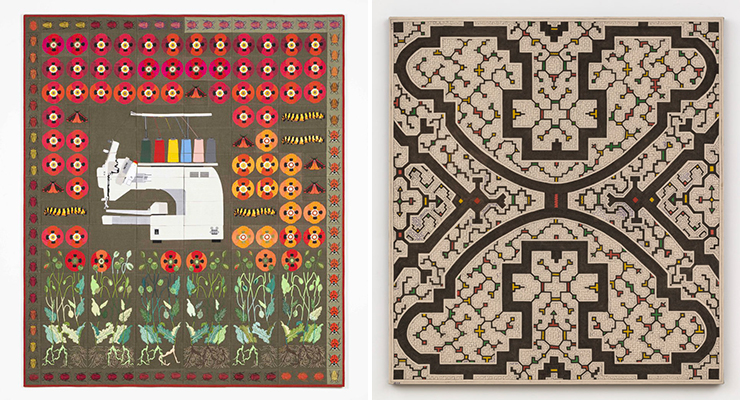
LEFT: Embroidered quilts by Daniel Dewar & Gregory Gicquel / RIGHT: Indigenous weavings by Sarah Flores
Modern techniques are now being folded into ancient ways, fusing digital technology with traditional fiber and textiles. Changing the game. Changing the outcome. The young and the undaunted expand from previous artists who, in turn, elevated the need for basic survival materials into a more creative cultural dialogue. After years of rabid and chronic interest in touching flat, sensory-deprived screens, there is a distinct pivot towards the next generation artists exploring their own histories using a more tactile avenue.
I was recently made aware of the fearless Aurora Molina’s hand and machine embroidery drawings, which led me to Bernice Steinbaum’s gallery, who is representing Molina. It was time to revisit the august Steinbaum in her Coconut Grove gallery of wonder and endless learning adventure. Steinbaum has never been intellectually absent in love and attention to her carefully chosen, often previously under-represented, artists. Equality in all facets has been the gallery’s strong interest. “They (currently 11 artists) make me see with a different eye” noted the gallerist. Pieces are never dull, never mundane.
Winning the Woman of the Year Award from the National Organization for Women underlined her import in pushing through previous unbalanced norms.
The first Bernice Steinbaum Gallery opened in Manhattan (1977), later recognizing the possibilities of Miami’s Wynwood section in 2000. I needn’t point out how that was a winning move to make at the beginning of this century.
The gallery trip brought me to two more very different, but equally skillful, textural-centric talents: Carrie Sieh and Shelly McCoy. It was a three-for-one fiber extravaganza.
Cuban born, artist Aurora Molina has resided in Coral Gables for 22 years. Watching her neighborhood go through an inevitable change, old homes were bulldozed, leaving gaping wounds on the landscape. Molina photographed the wreckage, printing results on canvas before building back decimated flora and remnants of destroyed residences with her own hand, embroidering onto images exposing disregard for the dislocation of people and greenery. Gone. Not forgotten.
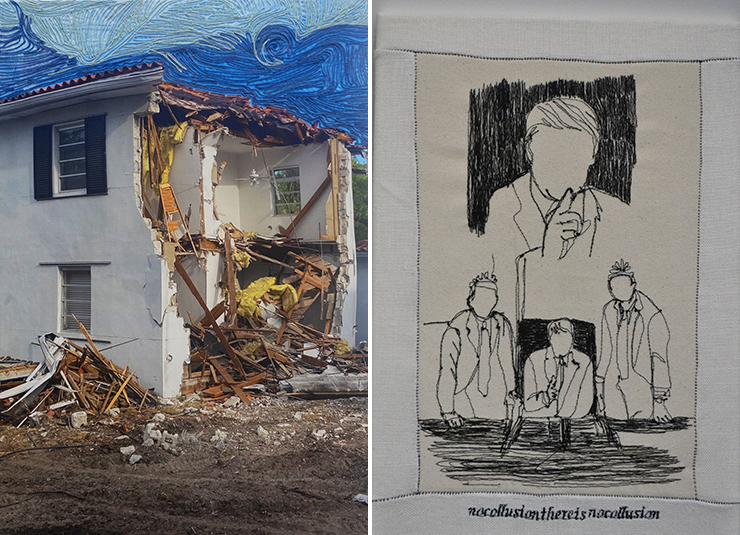
Artwork by Aurora Molina: "New Neighborhood" and "No Collusion" (Photos from Bernice Steinbaum Gallery)
As Steinbaum explains technique and meaning, my gaze floats over Molina’s caring hand on the canvas, depicting the remains of lives by painting with machine embroidery and a punch needle. The poignant series is titled “New Neighborhood”.
Steinbaum continues the tour as we stroll to the next room. “Walk up to the picture of that man,” she instructs. I do as I’m told. Growing nearer, the “painting” morphs into carefully placed shreds of cloth representing each brush load of paint. I’m knocked out and must go back and forth one more time. “Who IS this?” I marvel, enjoying every revelation. “Shelly McCoy, a Canadian artist. She uses all the techniques of a painter.” shares Steinbaum.
After some discussion, we move on to artist Carrie Sieh, a tour de force in her ability to translate thought/concepts into a distinct style. Clearly, difficulty of implementation is no deterrent for Sieh.
Steinbaum on Sieh: “I was very interested in the Industrial Revolution. I wanted to know how women moved into that arena.” Indicating the subject of a Sieh piece in front of me: “These (embroidered images) are machines that women learned to work on.” All Sieh’s work here is “done on machine, except when it comes to the flowers which are done by hand.” Steinbaum continues. Impeccably executed, the artist's message is “no matter what happens, nature will survive.” I nod in agreement.
The artist’s dream to work on sheetrock was granted when Steinbaum removed a piece of her own wall. Sieh drilled holes for adding embroidery stitches into the sheetrock to show the rows of houses in an Industrial Revolution mill town. She is a master of the usage of thread to indicate shadow and depth.
Steinbaum is her own walking display of creativity, choice of clothing an explosion of beautifully constructed daring. I never confuse her with anyone else, a visual sense of humor and impeccable interest in the artists who she represents makes me want to sift through her thoughts. She trusts her own mind and instincts. So do we. Make it a point to visit the Steinbaum Gallery (booth #AM527) at Art Miami during Art Week.
Dropping a teaser, Steinbaum leaves me with this: “Wait’ll you see Aurora’s (Molina) piece in Art Miami, she’s gone over the top.”
We wouldn’t miss it.
I touch base with Molina...
"What was the first thing that spoke to you on the concept of using fiber arts to express personal thoughts?," I ask.
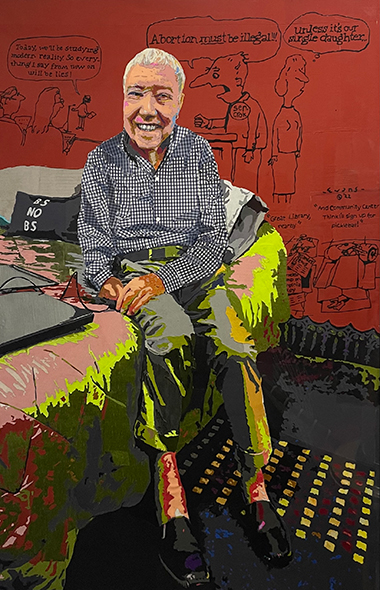
Shelly McCoy, Peter Evans (Photo from Bernice Steinbaum Gallery)
“I'll never forget the day I had my ‘aha moment.’ It was during a class at FIU called Fiber Painting, taught by Pip Brant, who would later become my mentor. As soon as I sat down at the sewing machine, I was transported back to when I was just nine years old, embroidering monograms on towels and T-shirts with my grandmother's 1920s sewing machine. Looking back, I realize that this experience connected me to generations of women who shared the same passion. That day, my dad took me to Sears to purchase a portable sewing machine, and I knew then that I was destined to become a fiber artist. Thread became my language, and the needle my pencil.
"Throughout the years, fiber arts has allowed me to connect with people from all over the world. In fact, over the last three years, I've had the pleasure of using fiber arts to bring people together. This led to the creation of FAMA (Fiber Art Miami Association) in 2020, which now boasts 250 members. Fiber art has a unique way of connecting us, with memory, life, and a DNA woven into its language. It has the power to mend, to heal, to connect, it is intricately interwoven into the language of women. It's both poetic and powerful.”
That conversation put FAMA (Fiber Arts Miami Association) on my radar. I’m taken with the blurb on their site:
“The Red String of Japan is a myth that explains human relations and how people are all predestined to meet by a red string that the gods tie to the pinky fingers of those who find each other in life. The myth states that a string will lead them to other persons with whom they will make history. Fiber artists Aurora Molina, Evelyn Politzer, and Alina Rodriguez-Rojo are kin spirits in textiles whose paths have become entangled in this conductive red string.”
If there is anything we need to underline in our cultural map amidst the thorny currents, is a cohesive force toward a larger goal.
And the door opens to new vistas. As you traverse the onslaught of 2023 Miami Art Week offerings, go on the hunt for a variety of fiber-based art. Along with Art Miami, visit Art Basel’s Meridians sector:
- Clearing Gallery - Sarah Flores, weavings from the Shipibo-Cobino Amazonian indigenous group and Daniel Dewar & Gregory Gicquel with embroidered quilts.
- Pippy Houldsworth Gallery - Nigerian artist Nengi Omuku.
- Bernice Steinbaum Gallery, Visit Booth AM527 at the Art Miami Fair.
The Bernice Steinbaum Gallery is at 2101 Tigertail Avenue, Miami, 33127
305-860-3681
bernicesteinbaum.gallery
The gallery is open Monday, Wednesday, and Friday from 10 a.m. to 4 p.m. Visiting the Tigertail gallery is by appointment only.FAMA (Fiber Artist of Miami Association)
www.fiberartists-miamiassociation.com




